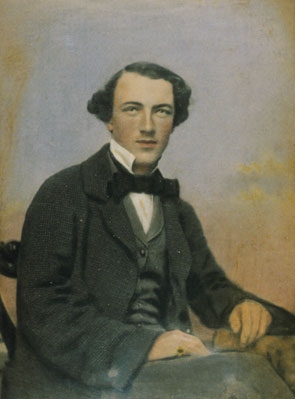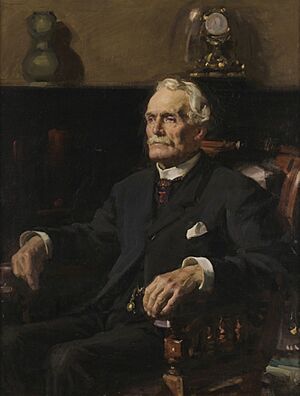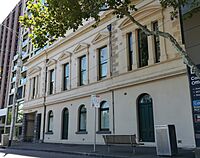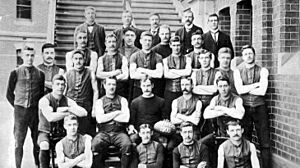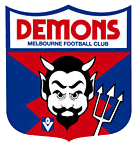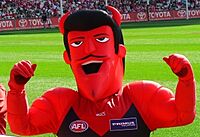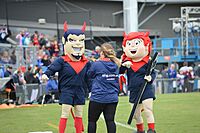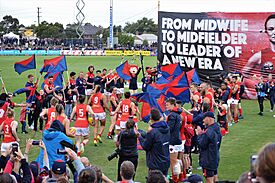Melbourne Football Club facts for kids
Quick facts for kids Melbourne Football Club |
||||
|---|---|---|---|---|
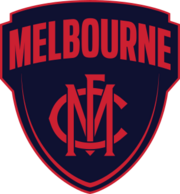 |
||||
| Names | ||||
| Full name | Melbourne Football Club Limited | |||
| Nickname(s) | AFL: Demons, Dees Indigenous rounds: Narrm |
|||
| Former nickname(s) | Redlegs, Fuchsias (prior to 1933) | |||
| 2023 season | ||||
| After finals | 6th | |||
| Home-and-away season | 4th | |||
| Leading goalkicker | Bayley Fritsch (38 goals) | |||
| Club details | ||||
| Founded | 1858 | |||
| Colours | Navy Blue Red | |||
| Competition | AFL: Men AFLW: Women |
|||
| President | Kate Roffey | |||
| CEO | Gary Pert | |||
| Coach | AFL: Simon Goodwin AFLW: Mick Stinear |
|||
| Captain(s) | AFL: Max Gawn AFLW: Kate Hore |
|||
| Premierships | VFL/AFL (13)
2022 (S7) Reserves (12)
Victorian (3)
|
|||
| Ground(s) | AFL: Melbourne Cricket Ground (100,024) AFLW: Casey Fields (9,000) |
|||
| Training ground(s) | AFL/AFLW: Gosch's Paddock, Casey Fields | |||
| Uniforms | ||||
|
||||
| Other information | ||||
| Official website | melbournefc.com.au | |||
The Melbourne Football Club, also known as the Demons, is a professional Australian rules football team. They play in the Australian Football League (AFL), which is the top league for the sport. The club is based in Melbourne, Victoria, and plays its home games at the famous Melbourne Cricket Ground (MCG).
Melbourne is known as the oldest professional club in any football sport in the world. Its story began in 1858 with a letter from Tom Wills, a cricket captain. He asked for a "foot-ball club" with its own "code of laws." An early Melbourne team played that winter. The club officially formed in May 1859. Wills and three others wrote "The Rules of the Melbourne Football Club." These rules became the foundation of Australian rules football.
The club was very strong in the early days of the game. It was a founding member of the Victorian Football Association (VFA) in 1877. Later, it helped start the Victorian Football League (VFL) in 1896, which is now the national AFL. Melbourne has won 13 VFL/AFL premierships (championships). Their most recent win was in 2021. The club also helped start the AFL Women's league (AFLW). They won their first AFLW premiership in 2022 season 7.
Since 2009, the football club has been a part of the Melbourne Cricket Club (MCC). They were also connected to the MCC between 1889 and 1980.
Contents
Club History
How it All Began: 1858 Foundations
In 1858, a football team called 'Melbourne' played games in Yarra Park. This team was led by Tom Wills. He was a famous athlete and cricket captain. On July 10, 1858, Wills wrote a letter. It was published in a Melbourne newspaper. In his letter, he asked for a "foot-ball club" with its own "code of laws." He wanted to help cricketers stay fit in winter.
Other people from the Melbourne Cricket Club (MCC) were also involved. These included Jerry Bryant and William Hammersley. The first game involving the Melbourne team might have been on August 14, 1858. Even though the club wasn't officially formed yet, 1858 is seen as the year the Melbourne Football Club began. It's also the start of Australian rules football.
Early Years and Rules: 1859–1876
In May 1859, the "Melbourne Football Club" started to grow. On May 14, they played their first game of the year. Later that month, Wills, Hammersley, and others met. They met at the Parade Hotel near the MCG. There, they wrote "The Rules of the Melbourne Football Club." These ten rules are the foundation of Australian rules football.
In the early years, games were casual. Teams often had to cancel if they didn't have enough players. Melbourne played its first game under the new rules against South Yarra in July 1859. Hammersley was Melbourne's first captain. In 1860, they played their first game against the Geelong Football Club. It ended in a draw.
By 1866, many clubs used an updated version of Melbourne's rules. These were drafted at a meeting led by Wills' cousin, H. C. A. Harrison. Harrison was very important to the club. He was often captain and later president. He was even called the "Father of Australian Football" in 1908.
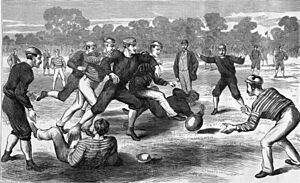
Joining the VFL: 1877–1932
In 1877, Melbourne became a founding member of the Victorian Football Association (VFA). They never won a VFA premiership. However, they were often one of the best teams. They finished second four times. In 1889, the Melbourne Football Club joined with the Melbourne Cricket Club. This helped the football club with its money problems. This partnership lasted a long time. It led to 12 VFL premierships between 1900 and 1964.
In 1897, Melbourne joined other strong VFA clubs. They formed the new Victorian Football League. In 1900, Melbourne won its first VFL premiership. They beat Fitzroy in a big upset. Fred McGinis was a champion player for the club.
During the 1910s, the team was sometimes called 'Fuchsias' or 'Redlegs'. In 1912, they adopted their club song, "You're A Grand Old Flag." Harry Brereton was the VFL's top goal scorer in 1911 and 1912. During World War I, 14 Melbourne players died fighting. The club did not play for three seasons, returning in 1919.
In 1926, Albert Chadwick led the team to its second league premiership. They beat Collingwood in the Grand Final. Ivor Warne-Smith was Melbourne's greatest player at this time. He won the club's first Brownlow Medal in the premiership year. He won a second Brownlow in 1928.
The Golden Era: 1933–1964
In 1933, Frank "Checker" Hughes became Melbourne's coach. He was tough and disciplined. He inspired the team to change their nickname from 'Fuchsias' to the 'Demons'. He told them, "You are playing like a lot of flowers. Lift your heads and play like demons!"
Under Hughes, with stars like captain Allan La Fontaine, Percy Beames, Jack Mueller, and Norm Smith, the Demons were very successful. They won three premierships in a row in 1939, 1940, and 1941.
Sadly, 11 players died serving in World War II. These included premiership players Keith 'Bluey' Truscott, Harold Ball, and Ron Barassi Sr. Club awards are named after them. The club's best and fairest award is the Keith 'Bluey' Truscott Trophy.

Hughes left in 1941 but returned in 1945. In 1946, Don Cordner won the Brownlow Medal. In 1948, Melbourne played Essendon in the Grand Final. The game was a draw, the first ever in a VFL Grand Final. Melbourne won the replay the next week, their sixth premiership. Fred Fanning was the VFL's top goal scorer in 1943, 1944, 1945, and 1947. He kicked a record 18 goals in one game in 1947.
Norm Smith returned as coach in 1952. He built a new team with future champion Ron Barassi. In 1955, the Demons won the premiership. They then won in 1956 and 1957. This made them the only VFL team to win three premierships in a row twice. They won five premierships between 1955 and 1960.
In 1964, Melbourne won its 12th VFL premiership. It was a thrilling Grand Final against Collingwood. Neil Crompton kicked the winning goal in the last seconds.
Tough Times: 1965–2020
In 1965, Ron Barassi left to coach Carlton. This was a big shock. Melbourne started the season well, winning eight games in a row. But then, the club's committee surprisingly fired coach Norm Smith. He was brought back, but the team's form dropped. Melbourne missed the finals for the first time since 1953. They would not play in another finals series until 1987.
Melbourne struggled through the late 1960s and 1970s. They finished last (wooden spoon) several times. Despite having talented players like Robert Flower, the club faced challenges. In 1979, they suffered their worst loss ever, losing by 190 points to Fitzroy.
In 1981, Ron Barassi returned as coach. He aimed to win a premiership in five years. Players like Brian Wilson and Peter Moore won Brownlow Medals for the club. But Barassi could not lead the Demons to the finals. John Northey took over as coach in 1986.
Melbourne finally made the finals in 1987. It was a dramatic finish to the season. They reached the Preliminary Final but lost to Hawthorn in the last seconds. In 1988, they played Hawthorn again in the Grand Final but lost by a large margin.
Jim Stynes won the Brownlow Medal in 1991. In 1996, the club faced serious money problems. There was a plan to merge with Hawthorn, but Hawthorn members rejected it. Joseph Gutnick became president and helped the club financially. Under new coach Neale Daniher, Melbourne reached the Preliminary Final in 1998.
In 2000, Melbourne made it to the Grand Final but lost to Essendon. In 2002, David Neitz won the Coleman Medal as the league's top goal scorer. In 2004, Melbourne player Troy Broadbridge died in the Boxing Day tsunami. The team later traveled to Thailand to help build a new school.
Melbourne continued to struggle from 2007 to 2020. They often finished at the bottom of the ladder. Jim Stynes became president in 2008 and helped raise money to clear the club's debt. Sadly, Stynes passed away in 2012 after a long fight with cancer. Paul Roos coached the team from 2014 to 2016, helping them improve. Simon Goodwin took over in 2017.
In 2017, Melbourne also started playing in the new AFL Women's competition. They made the AFL finals in 2018 for the first time since 2006. They reached the Preliminary Final but lost to West Coast.
Premiership Success: 2021–Present
In 2021, Melbourne had an amazing season. They won their first nine games. They finished the season as minor premiers (top of the ladder) for the first time since 1964. After winning their qualifying and preliminary finals, the Demons reached their first Grand Final since 2000.
On September 25, Melbourne won its 13th VFL/AFL premiership. They beat the Western Bulldogs by 74 points in the Grand Final in Perth. It was their first premiership since 1964. Christian Petracca was named the best player on the ground, winning the Norm Smith Medal.
| 2021 AFL Grand Final | G | B | Total |
| 21 | 14 | 140 | |
| 10 | 6 | 66 | |
| Venue: Perth Stadium | Crowd: 61,118 | ||
Melbourne's premiership defense in 2022 started strong. They won their first 10 games. However, their form became inconsistent later in the season. They finished second but lost in the finals. In 2023, they had a similar season, finishing fourth. They again lost in the second week of the finals. This made them the first team to lose in straight sets (two losses in a row) in two seasons under the current AFL finals system.
Club Symbols
Team Colors
In 1859, early Melbourne team members wore both red and blue. These colors quickly became linked with the club. However, they were not part of the official uniform at first.
In 1872, a club member brought red stockings from England. These were worn with blue shorts and jerseys, and red caps. This is when the team became known as the 'Redlegs'.
Uniforms Over Time
In the very early days of Australian football, players wore their own sports clothes. Many Melbourne players were also in the Melbourne Cricket Club. So, they often wore mostly white clothes. This led to the team being called the 'Invincible Whites'. For a short time in 1861 and 1862, the club wore magenta shirts, but they soon stopped.
From 1872, a more standard uniform was used. Players started wearing navy woollen guernseys (jerseys). These were better for winter games. The Melbourne team stood out with red socks and a red cap. In 1884, a canvas guernsey with a red leather stripe was introduced.
When Melbourne rejoined the competition in 1919, they used a standard uniform. It had a red V-shape on a navy jumper. In 1925, the V was made smaller. A red horizontal band was added to the waist.
The current club jumper has a red V-shaped yoke on a navy background. It was first used in 1935. It has stayed mostly the same since then. For a period between 1975 and 1986, a royal blue was used because of color television.
Melbourne also has a "clash strip" (alternate uniform). It was new in 2018. It looks like a retro version of the home strip. It is royal blue with a red yoke. It includes white shorts, like those worn between 1975 and 1986.
New Balance has made Melbourne's uniforms since 2011.
How the Uniform Changed
Here's how Melbourne's guernsey designs have changed over the years:
|
1858–61 & 1863–71
|
1861–62
|
1872–83
|
1884–1915
|
1905–15
|
|
1919–24
|
1925–34
|
1935–74
|
1975–86
|
1987–present
|
Club Mascots
In 1933, Melbourne changed its nickname to the 'Demons'. This was inspired by coach Frank "Checker" Hughes. He told his players to "lift your heads and play like demons!"
Over the years, the club has used different demon mascots. This includes Ronald Deeman from the AFL Mascot Manor.
The current club mascots are Chuck, Checker, and Cheeky. Chuck is named after coach Frank "Checker" Hughes. Daisy is named after Daisy Pearce, the first captain of the women's team.
Team Song
Melbourne's official club song is "It's a Grand Old Flag." It uses the tune of George M. Cohan's 1906 song "You're a Grand Old Flag." The club first used this song in 1912.
Here is the main verse they sing: It's a grand old flag, it’s a high-flying flag, It’s the emblem for me and for you; It’s the emblem of the team we love, The team of the Red and the Blue. Every heart beats true for the Red and the Blue, And we sing this song to you: Should old acquaintance be forgot, Keep your eye on the Red and the Blue.
A second verse was written in 1940 by Keith "Bluey" Truscott. It mentions the club's premiership wins. The club brought back this original second verse for the 2011 season.
Home Grounds and Training
Melbourne's main home ground has been the Melbourne Cricket Ground (MCG) since 1889. The MCC operates and partly owns the MCG. The two clubs were connected until 1980, then reconnected in 2009. The team trained at the MCG until 1985. Then they moved to the Junction Oval until 2010.
In 2009, the Demons moved their training to Casey Fields. Now, their football offices and indoor training are at AAMI Park. Their main offices are at the MCG. The team trains on Gosch's Paddock, a public oval nearby. This oval was improved in 2021/22 to match the size of the MCG.
Besides the MCG, Melbourne also plays some home games in the Northern Territory. They have played one home game there each year since 2010.
Melbourne also has a presence at Casey Fields in Cranbourne East. This is the home ground for their AFLW team and their VFL/VFLW affiliate, the Casey Demons.
Supporters and Members
Melbourne's membership and game attendance have steadily grown since 1996. They have had over 30,000 members since 2009. In May 2017, Melbourne reached 40,000 members for the first time. In May 2019, they reached 50,000 members. In 2023, they had 70,785 members.
| Year | Members | Finishing position including finals position |
|---|---|---|
| 1984 | 6,297 | 9th |
| 1985 | 5,801 | 11th |
| 1986 | 4,511 | 11th |
| 1987 | 3,122 | 3rd |
| 1988 | 10,078 | 2nd |
| 1989 | 8,184 | 4th |
| 1990 | 10,111 | 4th |
| 1991 | 10,153 | 4th |
| 1992 | 8,681 | 11th |
| 1993 | 10,097 | 10th |
| 1994 | 10,648 | 4th |
| 1995 | 9,544 | 9th |
| 1996 | 12,964 | 14th |
| 1997 | 15,350 | 16th |
| 1998 | 17,870 | 4th |
| 1999 | 19,713 | 14th |
| 2000 | 18,227 | 2nd |
| 2001 | 22,940 | 11th |
| 2002 | 20,152 | 6th |
| 2003 | 20,844 | 14th |
| 2004 | 25,252 | 7th |
| 2005 | 24,220 | 8th |
| 2006 | 24,698 | 5th |
| 2007 | 28,077 | 14th |
| 2008 | 29,619 | 16th |
| 2009 | 31,506 | 16th |
| 2010 | 33,358 | 12th |
| 2011 | 36,937 | 13th |
| 2012 | 35,345 | 16th |
| 2013 | 33,177 | 17th |
| 2014 | 35,911 | 17th |
| 2015 | 35,953 | 13th |
| 2016 | 39,211 | 11th |
| 2017 | 42,233 | 9th |
| 2018 | 44,279 | 4th |
| 2019 | 52,421 | 17th |
| 2020 | 40,571 | 9th |
| 2021 | 53,188 | 1st |
| 2022 | 66,484 | 5th |
| 2023 | 70,785 | 6th |
Club Achievements
Premiership Wins
Melbourne has won many championships across different leagues and levels:
| Premierships | |||
| Competition | Level | Wins | Years Won |
|---|---|---|---|
| Australian Football League | Seniors | 13 | 1900, 1926, 1939, 1940, 1941, 1948, 1955, 1956, 1957, 1959, 1960, 1964, 2021 |
| Reserves (1919–1999) | 12 | 1931, 1932, 1933, 1934, 1935, 1939, 1949, 1956, 1969, 1970, 1984, 1993 | |
| Under 19s (1946–1991) | 6 | 1947, 1953, 1964, 1971, 1981, 1983 | |
| AFL Women's | Seniors | 1 | 2022 (S7) |
| Victorian Premiership | Seniors (1870–1876) | 3 | 1870, 1872, 1876 |
Other Awards and Honors
Melbourne has also won other titles:
| Other titles and honours | |||
| McClelland Trophy | Various | 6 | 1955, 1956, 1958, 1990, 2021, 2023 |
| AFLX Tournament | Seniors | 1 | 2018 |
| VFL/AFL pre-season competition | Seniors | 1 | 1989 |
| VFL Night Series | Seniors | 2 | 1971, 1987 |
| Lightning Premiership | Seniors | 1 | 1952 |
Team of the Century
The Melbourne Football Club Team of the Century was announced on June 24, 2000. It honors the best players from the club's history.
| B: | John Beckwith | Tassie Johnson | Don Cordner |
| HB: | Noel McMahen | Gary Hardeman | Don Williams |
| C: | Brian Dixon | Allan La Fontaine | Robert Flower |
| HF: | Hassa Mann | Ivor Warne-Smith | Garry Lyon |
| F: | Jack Mueller | Norm Smith | Percy Beames |
| Foll: | Denis Cordner | Ron Barassi (Captain) | Stuart Spencer |
| Int: | Frank Adams | Albert Chadwick | Wally Lock |
| Laurie Mithen | Jim Stynes | Todd Viney | |
| Coach: | Norm Smith | ||
Hall of Fame
The Melbourne Football Club Hall of Fame started in 2001. It includes five legends and many other important people from the club's history.
| Melbourne Football Club | |||||||||||||||||||||||||||||||||||||||||||||
|---|---|---|---|---|---|---|---|---|---|---|---|---|---|---|---|---|---|---|---|---|---|---|---|---|---|---|---|---|---|---|---|---|---|---|---|---|---|---|---|---|---|---|---|---|---|
| Hall of Fame | |||||||||||||||||||||||||||||||||||||||||||||
Legends
|
Match Records
- Highest score: 182 points
Round 21, 1986 (MCG) – Melbourne 28.14 (182) vs North Melbourne 14.13 (97)
Round 5, 1991 (MCG) – Melbourne 28.14 (182) vs North Melbourne 17.10 (112) - Lowest score: 2 points
Round 16, 1899 (Brunswick Street Oval) – Melbourne 0.2 (2) vs Fitzroy 5.10 (40) - Highest score given up: 238 points
Round 17, 1979 (Waverley Park) – Melbourne 6.12 (48) vs Fitzroy 36.22 (238) - Lowest score given up: 8 points
Round 7, 1903 (MCG) – Melbourne 4.8 (32) vs Carlton 1.2 (8) - Biggest winning margin: 141 points
Round 9, 1926 (MCG) – Melbourne 21.28 (154) vs Hawthorn 1.7 (13) - Biggest losing margin: 190 points
Round 17, 1979 (Waverley Park) – Melbourne 6.12 (48) vs Fitzroy 36.22 (238) - Longest winning streak: 19 games
Round 15, 1955 vs North Melbourne (MCG) to round 13, 1956 vs Carlton (MCG) - Longest losing streak: 20 games
Round 4, 1981 vs St Kilda (MCG) to round 1, 1982 vs Sydney (SCG) - Record attendance (home and away game): 99,346
Round 10, 1958 (MCG) vs Collingwood - Record attendance (finals match): 115,802
Grand Final, 1956 (MCG) vs Collingwood - Most goals in a match by one player: 18 goals
Fred Fanning – round 19, 1947 (Junction Oval) vs St Kilda
Current Squad
| Senior list | Rookie list | Coaching staff | |||||||
|---|---|---|---|---|---|---|---|---|---|
|
|
|
Head coach
Assistant coaches
Updated: 16 June 2025 |
||||||
Individual Player Awards
Brownlow Medal Winners
The Brownlow Medal is given to the best and fairest player in the AFL.
- Ivor Warne-Smith (1926, 1928)
- Don Cordner (1946)
- Brian Wilson (1982)
- Peter Moore (1984)
- Jim Stynes (1991)
- Shane Woewodin (2000)
Coleman Medal Winners
The Coleman Medal is given to the player who kicks the most goals in a season.
- David Neitz (2002)
AFL Rising Star Winners
The AFL Rising Star award is given to the best young player in the league.
- Jared Rivers (2004)
- Jesse Hogan (2015)
- Luke Jackson (2021)
Mark of the Year Winners
This award is for the best mark (catch) of the year.
- Shaun Smith (1995) (Mark of the Century)
- Michael Newton (2007)
- Liam Jurrah (2010)
- Jeremy Howe (2012)
Goal of the Year Winners
This award is for the best goal of the year.
- Jeff Farmer (1998)
All-Australian Players (since 1991)
The All-Australian team is a dream team of the best players from across the league each year.
- Jim Stynes (1991, 1993)
- Garry Lyon (1993, 1994, 1995)
- David Neitz (1995, 2002)
- Todd Viney (1998)
- Jeff Farmer (2000)
- Adem Yze (2002)
- Jeff White (2004)
- James McDonald (2006)
- James Frawley (2010)
- Mark Jamar (2010)
- Max Gawn (2016, 2018, 2019, 2020, 2021 (Captain), 2022)
- Michael Hibberd (2017)
- Clayton Oliver (2018, 2021, 2022)
- Christian Petracca (2020, 2021, 2022, 2023)
- Jake Lever (2021)
- Steven May (2021, 2022)
- Simon Goodwin (2021 (Coach))
AFL Women's Team
In June 2013, the club had a women's team called the Chappettes. They played against the Western Bulldogs in the first AFL-approved women's exhibition match. This game was held at the MCG. The two teams played each other every year for three years.
In 2016, the AFL announced plans for AFL Women's, a national women's league. Melbourne was one of the first eight clubs to be given a license.
The club's first players were star signings Daisy Pearce and Melissa Hickey. The team was completed later that year with players chosen in the draft. Mick Stinear became the team's first head coach in September 2016.
Current AFLW Squad
| Senior list | Rookie list | Coaching staff | |||||||
|---|---|---|---|---|---|---|---|---|---|
|
Head coach
Assistant coaches
Updated: 16 June 2025 |
||||||||
AFLW Season Summaries
| Melbourne AFLW Honour Roll | ||||||||
|---|---|---|---|---|---|---|---|---|
| Season | Ladder | W–L–D | Finals | Coach | Captain(s) | Best and fairest | Leading goal kicker | |
| 2017 | 3rd | 5–2–0 | DNQ | Mick Stinear | Daisy Pearce | Daisy Pearce | Alyssa Mifsud (9) | |
| 2018 | 3rd | 4–3–0 | DNQ | Mick Stinear | Daisy Pearce | Daisy Pearce (2) | Tegan Cunningham (9) | |
| 2019 | 4th ^ | 4–3–0 | DNQ | Mick Stinear | Elise O'Dea & Shelley Scott | Karen Paxman | Tegan Cunningham (8) | |
| 2020 | 4th ^ | 4–2–0 | Semi-final | Mick Stinear | Daisy Pearce | Shelley Scott | Kate Hore (5) | |
| 2021 | 4th | 7–2–0 | Preliminary final | Mick Stinear | Daisy Pearce | Tyla Hanks & Karen Paxman (2) | Kate Hore (12) | |
| 2022 (S6) | 2nd | 9–1–0 | Grand final | Mick Stinear | Daisy Pearce | Daisy Pearce (3) | Tayla Harris (18) | |
| 2022 (S7) | 2nd | 9–1–0 | Premiers | Mick Stinear | Daisy Pearce | Kate Hore | Kate Hore (17) | |
| 2023 | 2nd | 8–2–0 | Semi Final | Mick Stinear | Kate Hore | Tyla Hanks (2) & Kate Hore (2) | Eden Zanker (23) | |
^ Denotes the ladder was split into two conferences. Figure refers to the club's overall finishing position in the home-and-away season.
See also
- Casey Demons (Melbourne works with Casey in the Victorian Football League and VFL Women's)
- List of Melbourne Football Club players
- List of Melbourne Football Club seasons
- Sport in Victoria
- Sport in Australia


